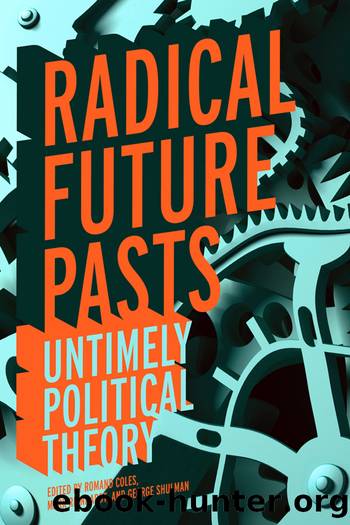Radical Future Pasts: Untimely Political Theory by Romand Coles & Mark Reinhardt & George Shulman

Author:Romand Coles & Mark Reinhardt & George Shulman [Coles, Romand & Reinhardt, Mark & Shulman, George]
Language: eng
Format: epub
Tags: Political Science, History & Theory, Philosophy, Political
ISBN: 9780813145297
Google: AmOungEACAAJ
Goodreads: 18507885
Publisher: University Press of Kentucky
Published: 2014-06-13T13:08:35+00:00
Toward the Peopleâs Reeducation: Holiday, Lynching, and the Performance of Pain
Whitmanâs understanding of art is preparatory work for what Holiday puts on display, attempting to awaken the self to the horror of lynching. As Whitman explains, âLiterature, Songs, Esthetics, &c, of a country are of importance principally because they furnish the materials and suggestions of Personality for the women and men of that country, and enforce them in a thousand effective ways.â75 To say that they are effective is an overstatement by Whitman, given the orator, poet, visual artist, or vocalistâs dependency on having the audience stand in the right relationship to what is being presented.
Enforcement strikes a more important note, for it does not bespeak a legalistic engagement, but an ethical one. As Whitman notes, and as Holiday seeks to do, song aims to bring about not only âgrowths,â but âremovalsâ as well. Holidayâs version of Meeropolâs song and her stylized performance of it seek to evoke in the listener a self-imposed mode of conduct toward black life that, if properly understood, will identify as âbitterâ the âfruitâ of human suffering hanging from trees. Whereas Jeffersonâs notion of democracy presupposes the people as an aspirational category, and Whitman renders the content of those aspirations efficacious through aesthetic appeals, it is in Holiday that we find these implicit theoretical frameworks, but the content she provides extends their reach to serve racial justice. âStrange Fruitâ is a song of democratic protest consistent with the activists and novelists of the 1920s and 1930sâboth a grievance about and an appeal to the polity. To this final theme we now turn. Let us begin with the historical framing.
Spectacle lynching achieved prominence in the wake of the Civil War to terrorize and humiliate African Americans. These events were not confined to a few random mobs but were sanctioned by local officials and often organized by ârespectableâ members of the community. Both the events and the publicity of them (distribution of lynching photographs and postcards) served as vehicles to circulate norms of white superiority over black subjects. The success of lynching depended not exclusively on the presence of the victims, but largely on white Americans serving as spectators. In these contexts, they were âsociallyâ habituated to find the displays âaesthetically acceptable.â76 Lynching photographs similar to Lawrence Beitlerâs (see figure 1) as well as detailed descriptions of such events were crucial weapons in the arsenal of white supremacy.
Increasingly during the 1920s and 1930s, however, both lynching photographs and literary recounting of lynching events also found their way into the tactics of antilynching activists, especially members of the National Association for the Advancement of Colored People (NAACP), novelists, and essayists. This is an odd occurrence. Why circulate images and propagate descriptions of such horrific acts? Just as lynching events and photographs tied white participants together in a community organized around norms and practices that involved policing and brutalizing black Americans, antilynching activists increasingly came to see the photographs as a visible testimony to the moral depravity of white Americans that might galvanize the black community and bring about the transformation of America.
Download
This site does not store any files on its server. We only index and link to content provided by other sites. Please contact the content providers to delete copyright contents if any and email us, we'll remove relevant links or contents immediately.
The remains of the day by Kazuo Ishiguro(8372)
Tools of Titans by Timothy Ferriss(7788)
Giovanni's Room by James Baldwin(6793)
The Black Swan by Nassim Nicholas Taleb(6748)
Inner Engineering: A Yogi's Guide to Joy by Sadhguru(6432)
The Way of Zen by Alan W. Watts(6281)
Asking the Right Questions: A Guide to Critical Thinking by M. Neil Browne & Stuart M. Keeley(5344)
The Power of Now: A Guide to Spiritual Enlightenment by Eckhart Tolle(5323)
The Six Wives Of Henry VIII (WOMEN IN HISTORY) by Fraser Antonia(5227)
Astrophysics for People in a Hurry by Neil DeGrasse Tyson(4995)
12 Rules for Life by Jordan B. Peterson(4158)
Housekeeping by Marilynne Robinson(4051)
The Ethical Slut by Janet W. Hardy(4026)
Skin in the Game by Nassim Nicholas Taleb(3961)
Double Down (Diary of a Wimpy Kid Book 11) by Jeff Kinney(3913)
Ikigai by Héctor García & Francesc Miralles(3872)
The Art of Happiness by The Dalai Lama(3840)
Skin in the Game: Hidden Asymmetries in Daily Life by Nassim Nicholas Taleb(3716)
Walking by Henry David Thoreau(3676)
